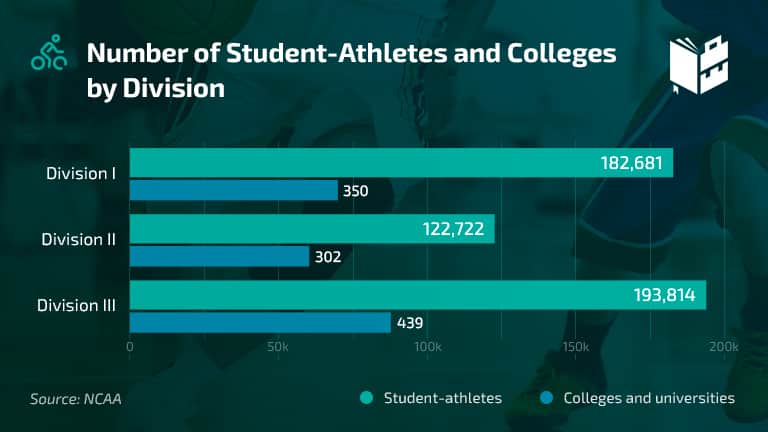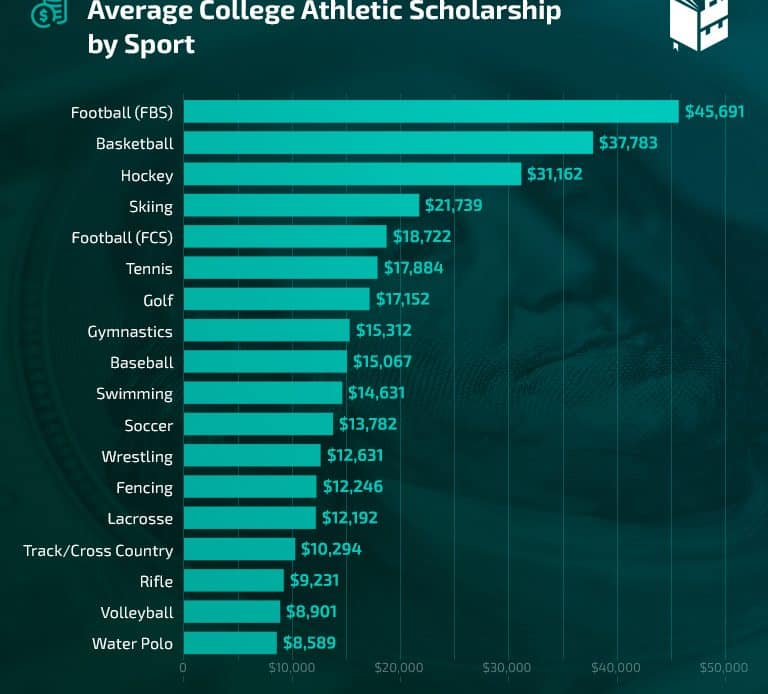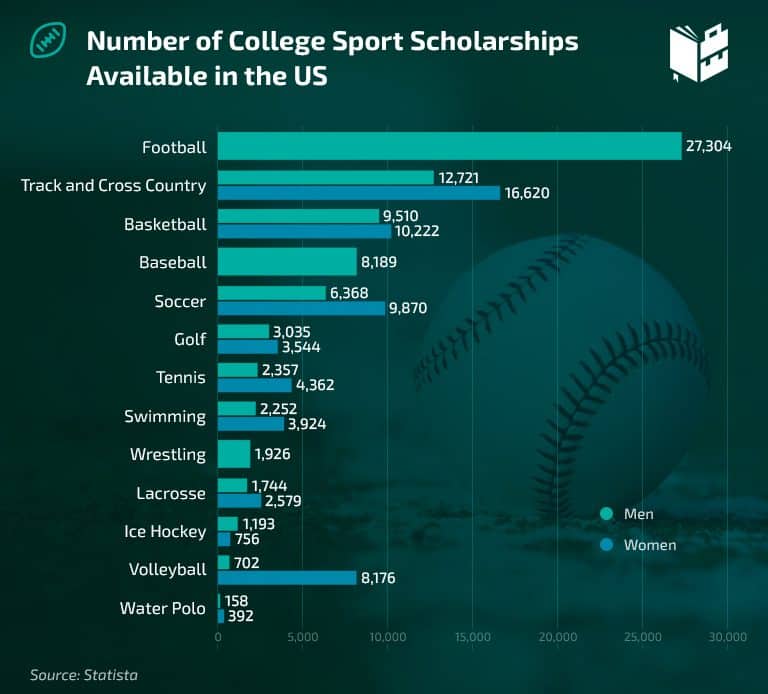Playing any kind of sport in the United States can help you get into a top university. Moreover, that can even secure enough money for your tuition and other living expenses. But how can students do that?
The answer is simple — by winning college sport scholarships. Of course, it is not easy to get a scholarship. In fact, there is a lot of planning involved, and it starts with an official recruitment process, frequent visits, scouting reports, negotiation, and eligibility. You should also fill out all the necessary college applications, just like any other student.
The benefits of being a student-athlete at a United States college are numerous. For example, you do not even have to be on top of your game to make your dreams a reality.
Key Facts About Collegiate Athletic Scholarships (Editor’s Choice)
- Students must earn at least a 2.3 GPA in core courses to receive a scholarship from an NCAA institution.
- The lowest average scholarship is given to water polo students ($8,589).
- Only athletes reaching levels 9 and 10 by their senior year can apply for a gymnastics scholarship.
- Varsity programs offer esports scholarships for six types of games.
- 57% of all Division I student-athletes receive financial aid.
- 63% of all Division II student-athletes receive financial aid.
- The average college scholarship per Division I student-athlete is $18,000.
- Only one percent of student-athletes receive full-ride scholarships.
College Athletic Scholarships Facts and Stats You Need to Know
College education in the United States can be the most rewarding thing for every student-athlete. However, if you want to find a suitable scholarship, you must be extremely willing to promote yourself.
Furthermore, there are three divisions of schools that provide scholarships annually. But, there’s so much more than many people don’t know about sports scholarships at the college level.
1. Approximately $2.7 billion in scholarship funds are set aside annually for competitive student-athletes at Division I and II levels of university sports.
(NFHS)
Scholarship stats show Universities are more likely to give sports scholarships to athletes who perform better in the classroom. So, one’s chances to get a scholarship increase with a better academic performance. Recent statistics indicate that 53% of Division I and 56% of Division II athletes receive athletic aid.
2. The highest number of student-athletes are in Division III, with up to 193,814 students enrolled in 439 colleges and universities.
(NCAA)
While Division I and Division II are priorities among student-athletes due to the highest college sports scholarship amounts, Division III is also a good choice. These schools provide a different perspective, as the focus is shifted toward academic success while at the same time offering competitive opportunities for all athletes and non-athletes.

3. 182,681 student-athletes in Division I are enrolled in 350 colleges and universities.
(NCAA)
Division I schools have the highest enrollment rate and manage the highest athletics budget available. These schools provide great opportunities to excel and a wide array of academic programs. The chances to be awarded full college athletic scholarships are the highest here, so it’s the best option for student-athletes.
4. Students must earn at least a 2.3 GPA in core courses to receive a scholarship from an NCAA institution.
(US News)
More precisely, students must complete 16 core courses according to the NCAA’s specifications and timeline. This is one of the typical academic requirements incoming students must meet to be eligible for a scholarship. NCAA scholarships are given to those who score the best academic results.
5. Division II consists of 122,722 student-athletes enrolled in 302 colleges and universities.
(NCAA)
While Division I may have the highest enrollment rate, Division II offers fantastic growth opportunities thanks to generous scholarships. As a result, many participants in these schools often end up as first-generation college students. This is mostly obtained through academic achievements, community engagement and, of course, high-level athletics competitions.
Stats About College Athletic Scholarships by the Sport Students Play
According to the United States Census Bureau, there is a lot more interest in sports among children and teenagers than 15 years ago. The NCAA reports that around 8 million high school students and student-athletes in the United States vie for the best scholarships, but only 6% make the cut to play a sport for an NCAA school.
The following data reveals information on athletic scholarships in various sports.
6. 7% of all high school graduates move to the NCAA.
(NCAA)
The easiest sports scholarships to get are definitely not the ones for college basketball players. Out of all high school graduates who move to NCAA, the lowest percentage competes in basketball — 3.5% of men and 4.1% of women.
7. The lowest average scholarship is given to water polo students — $8,589.
(Scholarship Stats)
The latest data available shows that there are only 1,741 male and 1,961 female college water polo players. Additionally, there are around 55,000 high school water polo players in both categories.
The competition is much lower than in other sports, but so are the average scholarships. Conversely, the average college sport scholarship is the highest in a football bowl subdivision — $45,691.

8. Rowing is the sport offering most scholarships to women, with 20 full-ride athletic scholarships per year.
(Recruiter Ref)
Extensive research shows that women can’t apply for college scholarships for every sport. Still, they have the best chances of getting athlete aid in rowing. Moreover, track and field (18), ice hockey (18), basketball (15), and equestrian (15) are right behind it.
9. FBS football gives 85 scholarships to male students, making it one of the best sports for scholarships for men.
(Recruiter Ref)
Moreover, scholarship stats suggest that the scholarship limit is 65 in FCS football. Overall, football offers the best chances of getting athletic aid as a male college student. Ice hockey and basketball follow football, with 18 and 13 scholarships. Moreover, track and field and lacrosse share fifth place with 12.6 scholarships.
10. Volleyball coaches at the D1 level can allocate 12 collegiate athletic scholarships for women and 4.5 for men.
(Berecruited)
College volleyball is predominantly played by women. In addition to more scholarship opportunities, volleyball is also a head count sport for women. This means that all the volleyball college scholarships for female players are full scholarships.
For men, college volleyball is an equivalency sport, and they get partial scholarships.
11. Only athletes reaching levels 9 and 10 by their senior year can apply for a gymnastics scholarship.
(CSS)
College gymnastics is a highly competitive sport at the NCAA D1, D2, and D3 levels. Therefore, college sport scholarships are saved for those who get good results at the local, state, regional, and national levels.
For students below level 9, walk-on opportunities could be the best option.
12. Varsity programs offer esports scholarships for six types of games.
(First Point USA)
In the last several years, esports has been one of the fastest-growing sports in the world. Currently, over 90 colleges and universities are members of the NACE. The varsity programs award students with scholarships for MOBA, first-person shooter, real-time strategy, sports, fighting, and collectible card games.
Other Interesting Facts About Sport Scholarships for College
There are a lot of advantages of being a student-athlete, like having a private tutor, various counselors, and opportunities to travel. Additionally, you can gain access to some of the best training facilities in the world.
You’ll get the chance to work with top coaches and fitness staff and stay on top of your game with the help of the best physiotherapists, physicians, and nutritionists. Of course, you’ll also have a chance to become a professional athlete or even an esports professional player. It’s important to know that college sport scholarships are not given only to would-be pros.
13. Three types of students can receive funding to play a sport at any United States college.
(Crimson Education)
Professional athletes, student-athletes, and recreational athletes are all qualified to receive any sort of funding. As a professional athlete, you will have access to the best facilities and trainers to provide you with a higher chance of becoming a professional. Also, you will be in the best position to receive a college sports scholarship.
Having the brains and brawn, student-athletes can skyrocket their chances of getting into Ivy League schools. Not everyone is participating to win, and many students just want to experience the college lifestyle. If you happen to be that person, then you are a recreational athlete. There are scholarships up for grabs for recreational athletes as well.
14. 57% of all Division I student-athletes receive some sort of financial aid.
(NCAA)
Many college student statistics state that student-athletes receive full college sport scholarships. Yet, 31% of students don’t have any kind of financial aid. However, that does not discourage them since the graduation success rate for Division I students is 88%.
15. 63% of all Division II student-athletes receive some sort of financial aid.
(NCAA)
Studies show that the chances of receiving any kind of financial aid are almost the same for Division I and Division II. For this to be true, the same number of students must enroll in both Divisions. Moreover, athletic scholarship statistics report that Division II has about 30% fewer students than Division I.
16. 80% of all Division III student-athletes receive some form of an academic grant.
(NCAA)
Compared to Division I and II, student-athletes in Division III schools do not receive the same financial support. Instead, the financial aid these students receive comes in the form of need-based scholarships or grants.
The average amount of money that Division II students receive is about $17,000 in the form of institutional gift aid.
17. The average athletic scholarship amount per Division I student-athlete is $18,000.
(US News)
Based on the data provided by the NCAA, $18,000 is the average amount Division I student-athletes get. Unfortunately, it rarely covers annual college costs, amounting to $21,184 at public schools and $35,087 at private schools per year.
18. 2% of all NCAA student-athletes make it as professionals.
(NCAA)
Education is important, as it is reported that many student-athletes depend more on college achievements than sports to succeed in life after college. Unfortunately, that also confirms the fact that the NCAA scholarships rules and requirements are pretty strict.
Students have to meet the sliding scale requirement of GPA and ACT or SAT test scores. Graduating from high school is a must as well. In essence, student-athletes must be good ambassadors of the school.
19. Division I enrolls the majority of undergraduates — 8,960.
(NCAA)
Among the three divisions, Division I enrolls the highest number of undergraduates. On the other hand, Division II and Division III enroll a significantly lower number of them. These numbers amount to 2,428 undergraduates in Division II and 1,740 undergraduates in Division III.
20. Athletic scholarships statistics show that over 7,500 more college sports scholarships were available to male athletes than female athletes in 2019/20.
(Statista)
College sports scholarships help both male and female students with college tuition fees. Education statistics show that over 177,000 scholarships were available to college students of both genders that school year. However, slightly more were given to male student-athletes than female student-athletes.

21. Only one percent of student-athletes receive full-ride scholarships.
(NCSA Sports)
Most student-athletes don’t get a full-ride scholarship. In fact, the percent of college athletes on full scholarship is pretty low. On the other hand, the majority of students aim for full-ride college scholarships because they cover tuition, fees, accommodation, and course material. Still, there are many schools to choose from. In addition, here is a list of 82 colleges that offer full-ride scholarships.
Conclusion
Every year, millions of parents enroll their children in various youth sports programs, hoping they will become good enough to compete for a scholarship that pays for college.
As we’ve already mentioned, the criteria for applying for college scholarships differ across schools, divisions, and by gender. Yet, it can be one of the most challenging experiences since not everyone can receive it.